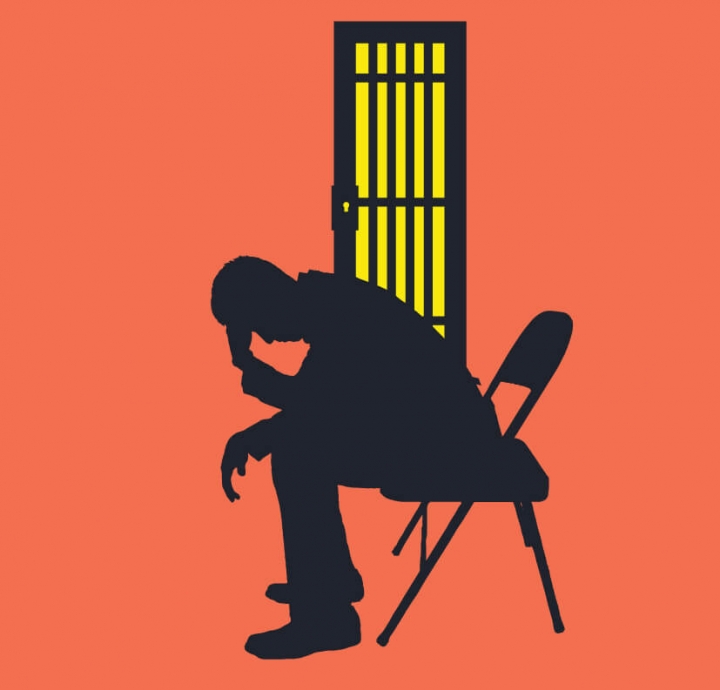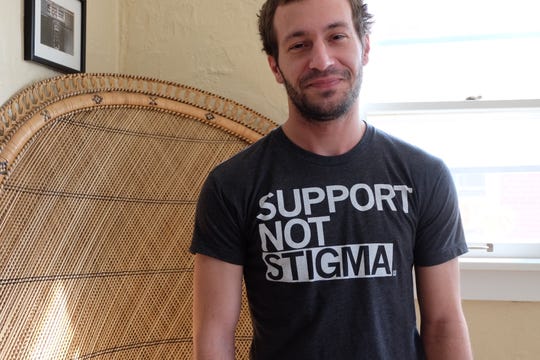Legislative Priorities
Access to MAT for Parole and Probation
As policy makers and other leaders in our country have tried to find the correct storyline on why our loved ones struggle with substance use, everyone has gotten jumbled up on what to believe and who to blame.
For many generations now, we’ve blamed the very people who are suffering. We’ve blamed the people who are in some ways, victims of biology and genetic chance.
Why? Because our minds have been our bodies’ greatest mystery.

Diseases that affect the mind are the ones that we understand the least in many respects and the ones whose victims’ symptoms are behavioral. They’ve been the hardest to understand because we’ve lacked the sophistication scientifically to explore the root causes. To understand the why behind chaotic substance use.
So, we passed laws that named them as criminals. We believed that the certainty of punishment would serve as a deterrent for drug use. If they broke these laws, we could send them away so they wouldn’t hurt us anymore. We believed they were choosing this lifestyle over us and so, we decided they needed consequences, not compassion.
Yet, as recidivism numbers laughed in the face of this narrative and as incarceration statistics proved the fallacy of these beliefs, others looked for clearer answers and more effective solutions.
Sending them away may have been easier than facing their behavior directly, but those with the desire to rewrite this story are succeeding, though they have yet to prevail. Even as the narrative slowly changes, we are still regularly sending our loved ones through the criminal justice system, a system that has not been found to ease their suffering and address their medical needs. Instead, we know that our loved ones and our towns benefit from being sent down an alternative path and into the healthcare system. Iowa’s own criminal justice experts are calling for it. Let’s get on the same page as our experts in order to implement the solutions that help our loved ones.

Medication Assisted Treatment (MAT)
For substance use disorders involving opioids, the solution is MAT.
MAT is set of FDA-approved pharmacological treatments for opioid use disorder. It’s similar to any chronic conditions (heart disease, diabetes, for example) or disorder (psychological or other), where a patient benefits most significantly from taking medication. Like other chronic conditions, medicine is the backbone of treatment, which in this case includes methadone, buprenorphine (Suboxone), or naltrexone (Vivitrol). Agonist drugs, methadone and buprenorphine, activate opioid receptors in the brain, preventing painful withdrawal symptoms and replacing essential molecules the body stops making on its own during addiction, without causing euphoria or dramatic changes in cognition or consciousness. MAT is effective at reducing use and helping people to lead stable, healthy lives – patients who are treated with these medications are less likely to die of an overdose over the long-term (i.e. they are less likely to relapse), and recover from an opioid use disorder.1
This treatment is proven effective but it has not been easy to access in Iowa. Many policy barriers have needed to be torn down as we work to rewrite the narrative of drug use in our state and at the federal policy level. While IHRC and its partners have had success at making it easier to obtain treatment, barriers to accessing MAT remain for individuals involved in Iowa’s criminal justice system.
The current story
You have broken the law in Iowa because of factors relating to your substance use disorder. Here are some likely scenarios that decide your fate:
Scenario 1
The judge places you on probation right away instead of sending you to prison. You’re now under the jurisdiction of the Iowa community-based corrections (CBC) system. CBCs are regional and are organized in alignment with Iowa’s eight judicial districts.CBC districts are not required to follow the policies of the Iowa Department of Corrections (DOC).
Scenario 2
You’re sent to one of nine Iowa state-run prisons. Crazily enough, this is ideal. The DOC screens for opioid dependency. If you were in MAT through an opioid treatment program (OTP) or if you were receiving buprenorphine products from a DATA2000 Waivered physician, (an approval program required by the US Department of Drug Enforcement Administration to prescribe opioid maintenance drugs like buprenorphine), the Iowa DOC will continue your treatment. They recognize that,
“Abrupt discontinuation of medications for opioid dependence management can cause severe withdrawal symptoms and interfere with the treatment of their disorder. To successfully manage the maintenance or detoxification of patients on these treatments, these patients will need to be maintained for an indefinite period of time on these medications until they can be successfully weaned off medication and given support and counseling to provide for successful re-entry.”2
Prior to discharge, if you’re still in the process of completing your treatment goals, you will be referred to a MAT provider for continuation of therapy, counseling and monitoring of your progress with treatment.
Following your time in prison, you are then placed on parole, under the jurisdiction of the Iowa CB system.

IHRC lost one of its employees and friends, Andrew Beeler on March 6,2019 due to an opioid overdose. Andy had expressed that he was too fearful to pursue MAT options because he was concerned he would be remanded to custody, as positive drug screens were a condition of his parole. He believed that if his parole officer discovered he was on MAT, he would know that Andy had used opioids illicitly (primarily to manage the pain caused by a shoulder injury after a fall on the ice), and he would be sent back to jail.
This loss emphasizes the need for individuals with substance use disorder to feel secure in pursuing evidence-based, physician-managed treatment options regardless of their parole or probation status.
To put it simply, Iowa’s local criminal justice systems have the flexibility to implement different policies and procedures for persons under their jurisdiction.
There is no required uniformity and your fate is dependent on what the policies are in the CBC district you’re assigned to, or the preferences and individual beliefs of the correctional officer assigned to supervise your case. You’re uncertain:
- Are there policies in place to screen you for substance use disorder?
- If you’re on MAT, will you be forced to discontinue treatment? Some community corrections officers believe that the presence of MAT in a person’s urine, even when prescribed by a health care provider, represent a failed drug test.
- If you’d like to begin MAT, will any of the physicians in your area provide it to you without you first being on opioids?
Many physicians won’t prescribe MAT without signs of the patient going through withdrawal. In many communities this could be the only physician who is approved to prescribe MAT. These physicians mistakenly equate “clean time” in prison with “clean time” in a treatment program. They are not the same. Clean time refers to the period of time that a patient abstains from using drugs. However, being forced to abstain because you are incarcerated is much different than willingly doing so under the care of a treatment program. You may have already gone through withdrawal and the drugs may be out of your system. However, it should not imply that you would not benefit from MAT after release when you are most vulnerable to relapse.
- Seeking help in this situation means that you have to violate your parole to satisfy the requirements to receive MAT. What would you do?
- Will federal law be followed?
Denial of MAT or mandated discontinuation of MAT for individuals with substance use disorder violates the Americans with Disabilities Act (ADA). Substance use disorder is classified as a disability, and denying access to medication and treatment for a disability is discriminatory. MAT is fairly new in Iowa though, and biases about its use remain prevalent. Anecdotally, there are discrepancies in how closely the ADA requirements are adhered to.
Your fate is also dependent on how your probation officer feels about substance use disorders and their treatments. You’re uncertain:
- Will your parole or probation officer understand the nature of your disease? Which narrative do they follow? Are you just a criminal who makes immoral choices or are you someone with an illness who needs help?
- Will they have understanding and empathy for the fact that you are at high risk of relapsing? Or that you may have already relapsed before seeking MAT? You sought help but was your original sin of relapsing enough to send you to prison? It’s hard to say how your probation officer will react, since they are allowed to exercise considerable discretion when it comes to revoking your probation or parole – there isn’t a clear set of standards.
While flexibility at the local level may be positive in some circumstances, for persons with substance use disorder, consistency is crucial to trust and understanding. Iowa laws must be written to encourage people to seek help without fear of consequences.
Changing the narrative
Iowa must work toward consistent application of evidence-based strategies, like removing barriers to accessing MAT while on parole/probation, across all the various jurisdictions. To accept substance use disorder as a disease is to be open to true rehabilitation and recovery. Treating people as criminals instead of patients has added to the issue of overcrowding in prisons. The current solutions, or lack thereof, for helping persons with substance use disorder who interact with the criminal justice system are not working. The data tells us it’s time to revise our strategy.
In Iowa, there were over 16,000 drug-related convictions alone in CY 2018.3 Drug offenses represented nearly 25% of new prison admissions from FY 2009-FY 2018. New offenses are new court-ordered commitments and probation revocations.4 In other words, these people have never been to prison in Iowa before. In FY 2019, “Drugs” represented 23% of the offense types for the 8,475 inmates in Iowa’s prisons.5
Iowa’s prison population is projected to rise to over 10,000 inmates by CY 2028. In a report on prison projections published by the Iowa Department of Human Rights in 2018, this alarming trend is discussed. One recommendation is as follows:
“One continued opportunity for change lies in the response to drug offenders. Drug offenders and drug sentences should continue to be examined to ensure that offenders committed to prison for drug offenses could not be more effectively rehabilitated elsewhere or, perhaps, committed to prison for shorter periods of time.”4
Offense Types FY19 Prison Offenders Served
Image adopted from: Iowa Department of Corrections. FY2019 Annual Report. (2019). Retrieved on December 30, 2019 from Page 20“
Recidivism rates are higher among incarcerated individuals with substance involvement than among other incarcerated individuals.6 This may be because a critical component of addiction is that it is a relapsing and remitting brain disease – a condition that by definition reoccurs. Assuring access to MAT without threat of consequences while on probation or parole is critical to achieving successful community reentry after being involved with the criminal justice system.
We see this policy change as complementary to the Iowa DOC’s stated Strategic Priority 1 (see below)4. The IHRC is working with legislators to introduce legislation that prohibits the criminal justice system in Iowa from taking action against a person under community supervision in the following ways:
- barring the person from seeking and receiving MAT to treat their substance use disorder as a condition of their release;
- denying their release because they are lawfully taking MAT;
- reprimanding them back into custody after release if they are lawfully taking MAT, or;
if they have taken illicit opioids in the first three months of their MAT treatment.
Iowa DOC's Strategic Priorities
Mission
Creating Opportunities for Safer Communities
Strategic Priority 1
Focus resources toward individuals most likely to reoffend
Strategic Goals
- Incarcerate only those who need it
- Staff in correlation with a person’s risk.
- Expand effective community supervision.
Strategic Priority 2
Focus on evidence-based and research-informed practices for improved returning-citizen reentry
Strategic Goals
- Invest in program models that reduce recidivism.
- Expand continuous quality improvement processes.
- Seek housing options for geriatric and seriously mentally ill individuals.
- Expand collaboration with other agencies/organizations.
Desired Outcomes
- Safe communities
- Quality services
- Accountability for those breaking the law
- Responsible use of taxpayer dollars
Adopted from: Iowa Department of Corrections. FY2019 Annual Report. (2019). Retrieved on December 30, 2019 from Page 20
This legislation will make community supervision more effective as those under its jurisdiction become more willing to be honest with their probation/parole officers about their treatment needs. Individuals engaged in treatment relationships, as opposed to enforcement relationships, develop trust and shared goals, which promotes disclosure. This trust could lead to a reduction of persons in prison for repeat offenses thus reallocating time, attention, state dollars, and resources to those offenders who need it. Not to mention saving the lives of the patients receiving MAT. How is this not worth a try?
The underlying science
We are sending sick people through the criminal justice system.
- A study by the National Center for Addiction and Substance Abuse at Columbia University in 2010 found that an estimated 65% of individuals in US jails or prisons have a substance use disorder and an additional 20% of individuals in US prisons are substance involved. Parolees and probationers have disproportionately higher rates of substance use disorders than the general US population.6
Upon their release, we know they are in an incredibly vulnerable period of time that they may not survive but we don’t offer help, we offer more conditions and consequences. We set them up for failure.
-
- Individuals who use drugs are at an especially high risk of overdose following release from a correctional facility. In a study conducted in 2007, during the first two weeks of release from prisons in Washington State, prior inmates were 12 times more likely to die than other state residents, with the leading cause of death being overdose.7
- The goal of probation or parole is to monitor an individual to prevent reincarceration and reoffending. In 2006, 53.4% of incarcerated individuals in the US with substance involvement were re-incarcerated, as opposed to 38.9% of other incarcerated individuals. Research shows that failure to receive needed treatment or access to services often leads to relapse and re-arrest, usually during the first 12 months after release.6
- More than half of individuals in treatment are likely to use substances while in treatment or shortly thereafter. Most individuals need at least three months in substance use treatment to achieve abstinence.8 If drug testing through probation or parole takes place during this time, an individual may be incarcerated before the treatment is to be effective.
There are solutions, though, if we can re-conceptualize people who use drugs as people in need of health care and medical support, rather than as criminals. These solutions involve more than just changing our imagination: they require changing our policies for those who are involved in the criminal justice system.
-
-
- MAT is approved by the FDA as a safe, effective treatment for opioid use disorders, yet individuals on parole or probation can be detained for a failed drug test based on MAT prescription use. A 2014 study found that 67% of probation and parole clients who received community-based buprenorphine treatment were still in treatment at three months post-baseline, and that there was a significant decline in the amount of self-reported heroin use.9
- In a clinical trial of more than 300 criminal justice-involved individuals with opioid use disorder, long-acting injectable naltrexone was compared side-by-side to basic counseling with no medication. During the 24-week study period, there were no overdose events among the 153 individuals offered long-acting naltrexone and 7 overdose events among the 155 individuals offered no medication.10 This tells us that patients who are ensured access to these medications are more likely to live.
-
Quite frankly, it is the right of people with substance use disorders to be treated as any other individual who has a chronic condition, like heart disease or diabetes, and who needs medication to manage their illness.
-
-
- Denial of MAT or mandated discontinuation of MAT for individuals with substance use disorder violates the Americans with Disabilities Act, as substance use disorder is classified as a disability, and denying access to medication and treatment for a disability is discriminatory.
- The requirement of individuals on probation or parole to remain drug free is unconstitutional if that person has a substance use disorder, because continuation of substances, regardless of possible negative consequences, is a symptom of that disorder. Therefore, incarceration before the completion of treatment interferes with the medical needs of the individual and discriminates against a person’s disability. Additionally, appropriate treatment is often difficult to find for individuals in Iowa with substance use disorder. Criminalizing individuals for experiencing symptoms of their medical condition, when treatment options are so limited, is an unfair use of the justice system.
-
Removing barriers to treatment also helps the criminal justice system stay focused on other priorities.
-
-
- Providing treatment, including MAT, is cost-effective, saving between $2 – $6 for every $1 spent, which in part reflects reductions in criminal behavior and re-incarceration. While MAT costs about $4,000 per person each year, incarceration in United States prisons has an average annual cost of $22,279 per person.11
- Additional dollars from the state can be saved through the prevention of disease transmission and overdose due to substance use. Both methadone and buprenorphine have been found to reduce health problems linked to heroin use, including the transmission of infectious diseases and overdose deaths. Because individuals on parole and probation have a higher probability of having substance use disorder, allowing MAT access to these individuals provides an important opportunity for preventing disease transmission and overdose.
- Substance use among incarcerated individuals also impacts families and children. In
2006, it is estimated that 1 million substance-involved parents, with 2.2 million minor children, were incarcerated in U.S. prisons and jails.6 Improving MAT access amongst individuals during a period of high likelihood for recidivism, relapse, and re-arrest can prevent negative consequences for children and families.
-
This is not a new idea
In 2015, the state of New York passed legislation to allow individuals on MAT to participate in judicial diversion programs and to ensure those participants would not inadvertently face probation violation charges due to the presence of MAT medications in drug screens.12
Following a 2000 court case in which Bradley Douglas Moore died from a heroin overdose after a drug court judge ordered him to discontinue his Methadone treatment, California passed two important pieces of legislation.13 One bill, the Substance Abuse and Crime Prevention Act of 2000 (“Prop. 36”) specifically includes “narcotic replacement therapy” in its definition of drug treatment, preventing judges from banning MAT in drug treatment programs.14 Another bill was passed to specifically allow MAT access for individuals with substance use disorder and which prevented those individuals from consideration for program violation solely on the basis of a positive urinalysis due to their prescribed medication.15

The ideal story

You have broken the law in Iowa because of factors relating to your substance use disorder. Thankfully, Iowa has passed laws to unify all state and local jurisdictions to assure that you have the supports you need for successful reentry in society. No one wants to see your freedom revoked because of your disease. This is a bright spot during a stressful time.
Whether you become incarcerated or whether you are placed on probation or parole, you will be screened for substance use disorder and will be placed on MAT. Iowa’s state prisons and the local CBC jurisdiction will operate under a consistent and unifying law that recognizes and strengthens all of the federal rights you have to access treatment for your disease. Just like someone who needs insulin for their diabetes or chemotherapy for their cancer – there will be no legal barriers to MAT. This means you will not be forced to discontinue MAT, be barred from starting MAT, and any failed drug tests directly related to taking MAT will not be grounds for violating conditions of your parole or probation. Since Iowa’s law now recognizes your vulnerability after your release, you may relapse right away but you will not be reprimanded back to prison. Not if you’ve asked for treatment right after the episode.
In this ideal story, Iowa’s morals and ethics related to helping people who want to help themselves will prevail and will allow you another chance to empower you to become a healthier version of yourself.
1Centers for Disease Control and Prevention. Evidence-Based Strategies for Preventing Opioid Overdose: What’s Working in the United States. National Center for Injury Prevention and Control, Centers for Disease Control and Prevention, U.S. Department of Health and Human Services, 2018. Accessed December 30, 2019 from http://www.cdc.gov/drugoverdose/pdf/pubs/2018-evidence-based-strategies.pdf
2Iowa Department of Corrections. Policy HSP-615 Medication Assisted Treatment for Opioid Use Disorder. (August 2017). Retrieved on December 30, 2019 from https://doc.iowa.gov/sites/default/files/hsp-615_medication_assisted_treatment_for_opioid_use_disorder.pdf
3Iowa Justice Data Warehouse. Easy Access to Iowa Adult Criminal Dispositions: Convictions Calendar year by Judicial district. [database] Retrieved on December 27, 2019 https://disposedcharges.iowa.gov/asp/display.asp
4Iowa Department of Human Rights, Division of Criminal and Juvenile Justice. (December 2018). The Correctional Policy Project: Iowa Prison Population Forecast FY 2018-2028. Retrieved on December 27, 2019 from Page 31, Table 5: https://humanrights.iowa.gov/sites/default/files/media/2018%20Iowa%20Prison%20Population%20Forecast%20FY%202018-FY%202028.pdf
5Iowa Department of Corrections. FY2019 Annual Report. (2019). Retrieved on December 30, 2019 from Page 20: https://www.legis.iowa.gov/docs/publications/df/1124961.pdf
6The Nat’l Ctr. for Addiction and Substance Abuse at Columbia Univ. (“CASA”), Behind Bars II: Substance Abuse and America’s Prison Population i (Feb. 2010).
7Binswanger, Ingrid A et al. “Release from prison–a high risk of death for former inmates.” The New England journal of medicine vol. 356,2 (2007): 157-65. doi:10.1056/NEJMsa064115
8NIDA. (2018, January 17). Principles of Drug Addiction Treatment: A Research-Based Guide (Third Edition). Retrieved from https://www.drugabuse.gov/publications/principles-drug-addiction-treatment-research-based-guide-third-edition on 2020, January 22
9Gordon, Michael S et al. “Buprenorphine Treatment for Probationers and Parolees.” Substance abuse vol. 36,2 (2015): 217-25. doi:10.1080/08897077.2014.902787
10Lee JD, Friedmann PD, Kinlock TW, et al. Extended-Release Naltrexone to Prevent Opioid Relapse in Criminal Justice Offenders. N Engl J Med. 2016;374(13):1232-1242. doi:10.1056/NEJMoa1505409
11Colleen O’Donnell, M.S.W. & Marcia Trick, M.S., Nat’l Ass’n of State Alcohol and Drug Abuse Directors, Inc., Methadone Maintenance Treatment and the Criminal Justice System 4 (Apr. 2006) (citing M. Rosenbaum et al., Treatment as Harm Reduction, Defunding as Harm Maximization: The Case of Methadone Maintenance, 28 J. of Psychoactive Drugs 3 at 241-249 (1996); Crim. Justice Inst., Corrections Yearbook: Adult Corrections 2002 105-06 (Camille Graham Camp ed., 2002)).
12Friedman, S. & Wagner-Goldstein, K. (2015). Medication-Assisted Treatment in Drug Courts Recommended Strategies. New York: Center for Court Innovation.
13Peggy Fulton Hora, Trading One Addiction for Another?, 2 J. of Maintenance in the Addictions 4 at 71, 73-74 (2005) (citing Va. Woman Jailed for Taking Methadone on Advice from Doctor, Join Together Online (Aug. 23, 2004), http://www.jointogether.org/sa/news/summaries/reader/0,1854,574254,00.html).
14National Families in Action. California Proposition 36, 2000, https://www.nationalfamilies.org/guide/california36-full.html.
15Penal Code Section 1000.6, Ch. 815 (2000). For the complete text, see http://leginfo.legislature.ca.gov/faces/codes_displaySection.xhtml?sectionNum=1000.6.&lawCode=PEN (last visited January 6, 2020).






